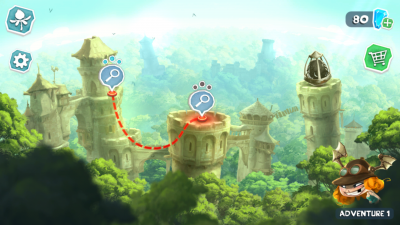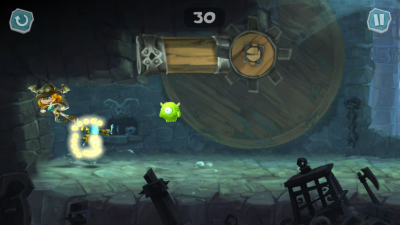Bastion
LQ: 9.15
Recommended Age: 10+
Skills Used: Planning, Working Memory, Mathematics, Reading

Rayman Adventures is a free mobile game in the popular Rayman series from developer Ubisoft, available for Android and iOS devices. The sidescrolling game has a unique control scheme that tempers the “endless running” style with a series of taps and swipes that allow players a surprising amount of freedom. Players will take control of Rayman or his Viking companion Barbara to short- and long-jump, dive, reverse direction, climb walls, and attack enemies as they fly through Olympus to recollect and return the ancient eggs (Incrediballs) that have been stolen from the sacred tree. Though Rayman Adventures is rated E for everyone, it does consistently feature cartoon fantasy violence. That being said, the gameplay and story are cutesy and simple enough to be enjoyed by younger kids, which is why we recommend this game to kids 6+.
Teachers: check out the classroom guide!
 Getting started and then maintaining attention and effort to tasks.
Getting started and then maintaining attention and effort to tasks.
As an “endless runner” style game in which players’ avatars move forward at a constant pace unless player input dictates otherwise, Rayman Adventures demands sustained attention and task persistence. If players don't ignore external distractions and focus on using the touch screen to make their avatar jump, duck, or attack, they risk missing items and points or getting hurt. Even when they do pay attention, their timing won't always be right, and it will often be necessary to start a level over in order to get enough points to receive chests of gems. This makes persistence a key quality for success in the game.
Developing a systematic approach for setting and achieving goals.
 Because well-timed player input is required to successfully jump, dive, climb walls, or attack enemies, looking ahead is vital. The game will put kids’ planning skills to the test, requiring them to make quick decisions as they hurtle through levels. An initial tutorial gives them a chance to learn moves and use them as they complete the first level, reinforcing the idea that learning how to do something is part of the planning process. At times, they'll have the opportunity to carefully assess an obstacle, usually as they run back and forth and jump to see what's above, but they'll still need to quickly form a step-by-step plan of action in their heads. They get the best practice at planning when they inevitably decide to go back to a level and try again.
Because well-timed player input is required to successfully jump, dive, climb walls, or attack enemies, looking ahead is vital. The game will put kids’ planning skills to the test, requiring them to make quick decisions as they hurtle through levels. An initial tutorial gives them a chance to learn moves and use them as they complete the first level, reinforcing the idea that learning how to do something is part of the planning process. At times, they'll have the opportunity to carefully assess an obstacle, usually as they run back and forth and jump to see what's above, but they'll still need to quickly form a step-by-step plan of action in their heads. They get the best practice at planning when they inevitably decide to go back to a level and try again.
All membership plans come with full access to our entire suite of tools learning guides, and resources. Here are a few of the ones we think you’ll like the most: